Sunder Nursery
Sunder Nursery, formerly called Azim Bagh or Bagh-e-Azeem, is a 16th-century heritage park complex adjacent to the Humayun's Tomb, a UNESCO World Heritage site in Delhi.[1] Originally known as Azim Bagh and built by the Mughals in the 16th century, it lies on the Mughal-era Grand Trunk Road, and is spread over 90 acres (36 hectare).[2][3] Future plans aim to link nearby areas to develop it into India's largest park covering 900 acres.[4][5]
| Sunder Nursery | |
|---|---|
| Central Park of Delhi, Azim Bagh | |
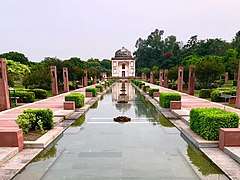 Sunderwala Burj and reflecting water canal | |

| |
| Type | Heritage Park, City Park |
| Location | New Delhi |
| Coordinates | 28.596874°N 77.245339°E, |
| Area | 90 acres (0.36 km2) |
| Created | 16th century |
| Designer |
|
| Owned by | Government of India |
| Operated by | |
| Status | Open all days from sunrise to sunset |
| Website | www.sundernursery.org |
Today Sunder Nursery contains fifteen heritage monuments of which 6 are UNESCO World Heritage sites, including Archaeological Survey of India (ASI) protected Sundarwala Burj, Sundarwala Mahal and Lakkarwala Burj.[2][6][7]
After renovations starting in 2007, the nursery reopened to public as a heritage park on 21 February 2018. Now it contains over 300 types of trees, making it Delhi's first arboretum.[7]
During the British rule, the nursery was established to grow experimental plants, which gave it its current designation as a nursery. The "Sunder" part of the name comes from the Sunder Burj tomb located in the same premises.[8][9] Although the name Sunder Nursery has still held, the park has been quoted to be a 'Delhi's Central Park' after renovations (though not to be confused with the central park in Connaught Place, New Delhi).[10]
Restoration
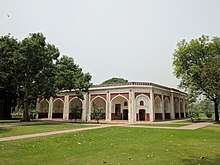

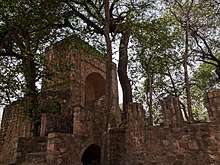
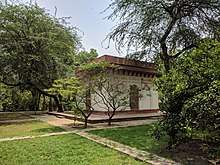
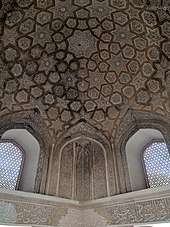
Nizamuddin Urban Renewal Project
Sunder Nursery is part of the larger Nizamuddin Urban Renewal Project master plan of the Aga Khan Trust, which involves restoration work on 30 nearby heritage structures.[11][12] Once complete, the park and resorted monuments will cover 900 acres (3.64 km sq).[4] Since 2007 conservation of over 50 monuments have taken place of which 12 were designated World Heritage Sites by UNESCO in 2016.[7]
Future plans aim to run the area as a public-private partnership (PPP) between the various government authorities in India and the Aga Khan Trust.[13]
Organisation and agencies involved
The garden complex is undergoing an extensive restoration project, undertaken by Aga Khan Trust for Culture India, jointly with Archaeological Survey of India (ASI) and Central Public Works Department (CPWD) which currently runs the garden.
All the agencies involved in this extensive restoration project are[4] -
Restoration of nursery
Plans for the project were drawn in 2007, and work on the third phase was initiated in 2010 and completed in 2018, with 90 acres of the park being opened to the public on 21 February 2018. The vice-president of India, M Venkaiah Naidu, was present during the inauguration along with various other dignitaries including the Aga Khan founder and chairman of the Aga Khan Development Network.[4][5]
Lying abandoned for decades much of the area was overgrown, and during the initial work some 1,000 trucks of rubble was removed, before the ground was levelled and subsequently classical Persian gardens were recreated, with fountains and water channels. Two main architectural features were restored. The Lakkarwala Burj tomb is now set in a new rose garden, while the 16th-century Sunderwala Burj tomb was restored as per the orange sandstone and white lime mortar used in its original design. Its red sandstone interior walls saw entire sections of white Quranic verses being recreated.[14] The garden replicates the four micro-habitat zones which were part of Delhi's original landscape namely Kohi (ridge), Bangar (alluvial), Khadar (riverine) and Dabar (marsh).[11]
Important features
Monuments
UNESCO World Heritage status has been given to the following six structures within Sunder Nursery - Sunder Burj, Sundarwala Mahal, Lakkarwala Burj, Mirza Muazzafar Hussain's Tomb, Chotta Bateshewala and the Unknown Mughal's tomb.[2]
Wildlife
Flora
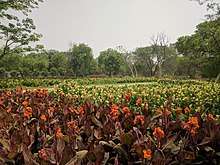

The area contains over 280 native tree species. Using GIS 4200 trees have been mapped. Apart from this there are around 80 types of bird species and 36 types of butterflies. The Bonsai House is home to some bonsai over 80 years old.[2][3]
Trees
Sunder Nursery is Delhi's first arboretum. It is home to some rare trees such as a Pink Cedar (Acrocarpus fraxinifolius), the only one in Delhi. Various other trees in the nursery are also only found here and nowhere else in Delhi such as Chukka (Croton roxburghii) and Carrotwood (Cupaniopsis anacardioides).[15]
A partial listing of trees and plants found -
- Amrood, Psidium guajava
- Peelu, Salvadora persica
- Sonjna, Moringa oleifera
- Marodphali, Fernandoa adenophyllum
- Chalta, Dilienia indica
- Badminton Ball Tree, Parkia biglandulosa
- Kaim, Mitragyna parvifolia
- Tun, Toona ciliata
- Siala, Markhamia Lutea
- Pinj, Firmiana colorata
- Adusa, Adhatoda Vasica
- Goolar, Ficus racemosa
- Brazilian ironwood, Caesalpinia ferrea
- Whistling pine, Casuarina equisetifolia
- Colville's glory, Colvillea racemosa
- Shisham, Dalbergia sissoo

Roses
The rose gardens host various types of roses. A partial list of rose varieties -
- Michael LIS
- Tata Pink
- Iceberg
- Black Pearl
- Oklahoma
- Bajazoo
- Charleston
- Pristine
- Gold Media
- Broadway
- BP Pal
- Christian Dior
- Folklore
Miniature Roses
- Don Don
- Merlin
Fauna
Birds
80 different species of birds have been located in the area through bird mapping. In 2014, the rare Ultramarine Flycatcher was spotted in the park area, a bird never seen before in New Delhi for many years. 36 types of butterfly have also been spotted in the park.[16] A partial listing of birds include[17] -
- Asian Pied Starling
- Eurasian Golden Oriole
- Coppersmith Barbet
- Eurasian Collared Dove
- Laughing Dove
- Red-wattled Lapwing
- Indian Roller
- Green Bee-eater
- Long-tailed shrike
- Black Drongo
- Indian Stone-curlew
- Eastern Cattle Egret
- Scaly-breasted Munia
- Red Avadavat
- Indian Pond Heron
- Grey-headed Canary-flycatcher
- Indian Silverbill
- Black-rumped Flameback
- Yellow-footed Green Pigeon
- Rufous Treepie
- Shikra
- Spotted Owlet
- Common Tailorbird
- Plum-headed Parakeet
- Ashy Prinia
- Oriental Magpie
- Red-breasted Flycatcher
- Black Redstart
Butterflies
A partial listing of butterfly varieties found[18] -
- Yellow Pansy
- White Arab
- Tiny Grass Blue
- Indian Palm Bob
- Plain Tiger
- Pioneer
- Common Emigrant
- Blue Pansy
- Banded Awl
- Peacock Pansy
- Lemon Pansy
- Grass Yellow
- Common mime
- Common Gull
- Common Mormon
Gallery
- Sunderwala Burj
 Unknown Mughal graves
Unknown Mughal graves Artificial lake
Artificial lake Amphitheatre, with Sunder Burj visible in the background
Amphitheatre, with Sunder Burj visible in the background
See also
References
- "A walk through one of UNESCO's World Heritage Sites: Delhi's Sunder Nursery". WION. Retrieved 13 March 2020.
- "Humayun's Tomb - Sunder Nursery - Hazrat Nizamuddin Basti | Aga Khan Development Network". www.akdn.org. Retrieved 25 April 2018.
- "Photos: Sunder Nursery near Humayun's Tomb opens as heritage park". Hindustan Times. Retrieved 25 April 2018.
- "Sunder Nursery debuts in heritage park avatar - Times of India". The Times of India. Retrieved 25 April 2018.
- Reporter, Staff (21 February 2018). "Sunder Nursery in full bloom". The Hindu. ISSN 0971-751X. Retrieved 25 April 2018.
- "10 years on, Sunder Nursery to debut as a heritage park - From nursery to heritage park". The Economic Times. Retrieved 25 April 2018.
- ""We will be involving community volunteers to effectively police the park" -Governance Now". Governance Now. 19 April 2018. Retrieved 25 April 2018.
- "Aga Khan revives lost 16th century Mughal garden in heart of Delhi". The Daily Telegraph. 1 September 2013. Retrieved 16 January 2014.
- "Sunder Nursery blooms into a park". Deccan Herald. 2 January 2013. Retrieved 16 January 2014.
- Sreevatsan, Ajai (22 February 2018). "Delhi's own 'central park' opens today". Livemint. Retrieved 25 April 2018.
- "16th-century lotus pond found in Sunder Nursery". The Times of India. Retrieved 16 January 2014.
- "Sunder Nursery, city's new oasis". Indian Express. 11 June 2010. Retrieved 16 January 2014.
- Venkataramakrishnan, Rohan. "Sunder Nursery gives Delhi a beautifully restored green space – and a template for heritage". Scroll.in. Retrieved 25 April 2018.
- "Ratish Nanda plans on creating huge new park in Delhi". CNN-IBN. 26 August 2013. Retrieved 16 January 2014.
- "Inventory of Sundar Nursery Trees". Outlook India. Retrieved 27 April 2018.
- "AKDN: AKDN". annualreport2015.nizamuddinrenewal.org. Retrieved 25 April 2018.
- Birds at Sunder Nursery, 26 April 2018, retrieved 27 April 2018
- Butterflies at Sunder Nursery, New Delhi, 26 April 2018, retrieved 27 April 2018
External links
| Wikimedia Commons has media related to Sunder Nursery. |